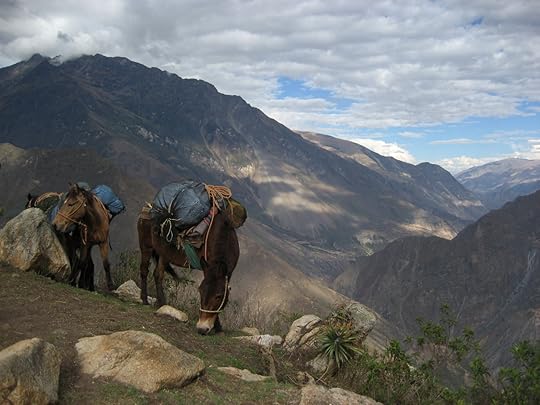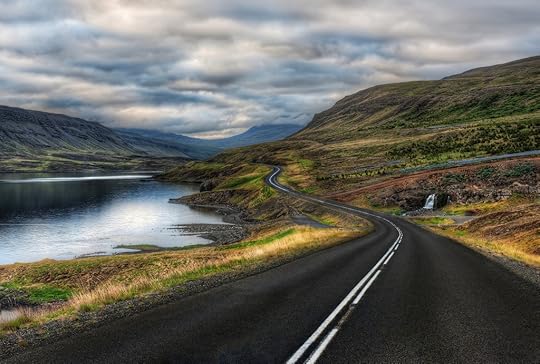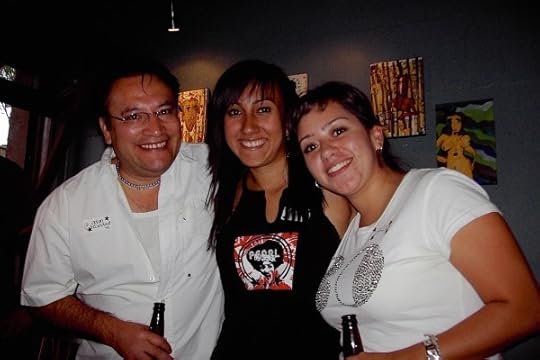Matador Network's Blog, page 2156
January 26, 2015
What Midwesterners take for granted

Photo: Travis Gertz
1. Knowing how to drive in every form of weather
Ever driven behind someone with Florida plates in the middle of a snow storm? Be grateful when you see a license plate from one of the Great Lakes states. They’ll be the ones flying by you going the speed limit on I-96 (or 20 mph over the speed limit on I-90) while you’re left squinting through all the snowflakes and crawling along the rumble strip. Rain, sleet, hail, snow, slush — we’ve seen it all and can handle our vehicle (usually without four-wheel drive) through it all.
2. Big Ten Football
Whether you love to hate Ohio State or are buddies with Bucky Badger, there is no conference in college football better than the Big Ten. Tailgating outside Kinnick Stadium or the Big House, that’s what Football Saturdays are all about. We have some of the most cut-throat rivalries in the NCAA, but in the end, all we really want is someone from the Big Ten representing in the BCS game.
3. A perfectly-timed, slightly self-deprecating, practical kind of humor
And no one else seems to quite get it. Your understated wit goes unnoticed by your “coastal” companions. Once you leave the Midwest (which you will because everyone does at some point), you’ll quickly develop an even deeper appreciation for Garrison Keillor and make sure you never miss another episode of A Prairie Home Companion. Because that guy, he gets it.
4. The significance of being the first frontier
If you were paying attention in your 8th grade history class, you probably learned about our beginnings in New England and the troubles happening down South, but the American values we cherish today were forged on the frontier. We have the original Midwesterners to thank for going all Democratic and revolting against the Eastern Ivy League mentality to head West to find the simpler things in life. Sure, Iowa has its share of churches and potlucks, but it was also the third state to legalize gay marriage. Welcome to the frontier…
5. Lake houses (and the Great Lakes of course)
Everybody knows somebody with a lake house, and those cottages up north are God’s gift to the Midwest. These are the places where priceless memories are made, and it’ll only cost you a tank of gas and a case of your host’s favorite beer. You’ll never forget your first polar bear dive and quickly learn that swimming in an enormous freshwater lake is so much better than constantly having to spit out salty sea water…
6. Hot dogs, deep dish, pasties, fish boils…
The South might have staked their claim on BBQ, and obviously lobster is just better in Maine, but there is something to be said about Midwestern cuisine. It just makes you feel fat and happy. Boiled fish and potatoes might not sound like the most appetizing dish, but paired with a Door County summer evening, you’ll have a night to remember.
7. “Midwest nice” and the meaning of hard work
Although the “Midwest nice” stereotype has its downfalls, for the most part, it works in our favor. People from the Midwest say please and thank you. They’ll stop to help you change your tire on the side of the road, and if they don’t, they’ll definitely feel bad about it until the next rest stop exit. A recruiter in Portland once told me he liked hiring Midwesterners because he knew they’d have a strong work ethic. I’ll take that reputation over the California valley girls any day.
8. Bell’s, Founders, New Glarus, Boulevard, Goose Island…
You’re welcome, rest of the world.
9. The month of October
The color spectrum can’t possibly be big enough to encapsulate every hue of orange, red, yellow, and green found in a Midwestern fall. We wait all year for that two week period where we get to break out our favorite jean jacket and crunch upon dead leaves in the crisp, autumn air. How do people live in places that don’t have seasons?!
10. An inexplicable ability to gravitate towards each other
Inevitably, either for college or after college, every Midwesterner picks a coast to try out. They pack their bags and get excited to leave the boring flatlands of Illinois or Indiana. They drive several thousand miles in their jam-packed, American-made car only to find that the first person they befriend in Oregon is actually from Michigan. Their favorite co-worker is from Minnesota, and the random Craigslist roommate they found reigns from Wisconsin. We are just pre-programmed to find each other.
11. Cornfields
Yep, I said it. Cornfields are not something to take for granted. They provide endless hours of entertainment, not to mention a great place to hide and steal a first kiss. Plus, there is nothing quite like driving past rolling cornfields at sunset or sinking your teeth into the first corn cob of the year’s harvest. It’s true, us Midwesterners do love our corn. 
January 25, 2015
Trekking in Patagonia with extreme wind (and stoke) [VID]
Big ups to GoPro flimmaker Teddy Cho for this sweet “cinematic hike” through Argentine Patagonia, including the O Trek in Torres del Paine, Fitz Roy, and a bit of Lago General Carrera (and Marble Caves). You can find more hikes on list (awesomely named) blog, LegDays. 
On the Way to School [vid]
Follow Matador on Vimeo
Follow Matador on YouTube
Follow four kids from four corners of the planet as they face the same, seemingly impossible challenge most Western kids take for granted every day: getting to school. And we’re not talking about a waltz down to the bus stop. Mountains, wheelchairs, raging rivers, wildlife — these intrepid kids face down incredible physical obstacles for their education.
French filmmaker Pascal Plisson has put together a stunning portrait of human struggle. He also picked four epic locations — we go from the savannahs of Kenya to the Atlas mountains in Morocco, Southern India to vast Patagonia. We tag along with the determined and adorable Jackson, Zahira, Samuel, and Carlito as they embark on a journey that will change their lives forever.
On the Way to School (Sur le Chemin de l’école) is in very limited, small-theater release in North America, but is available on Blu-ray and DVD from Amazon. Next time your little one complains about walking to school or the bus stop, sit them down to watch this. Also, take a moment to learn about the nonprofit foundation behind the film’s production here: www.surlechemindelecole.org 
Discover your own Machu Picchu

Photo: Rick McCharles
RESTORATION OF this small Incan city only began in the ’90s. The first visitors had to cross the Apurímac River via a rope bridge to reach it.
During a typical afternoon at Machu Picchu, you’ll be one among 2,500. At Choquequirao, you might see six or seven other visitors.
While the ruins currently sit under the radar, they won’t stay there forever. The regional government is investing $50 million into a cable car project that could get you to this site in 15 minutes intead of the current four-day trek. As early as 2016, there might be around 3,000 people visiting choquequirao per day. Consider yourself warned — get there now.
Practicalities

Photo: Daniel Pereira
Choquequirao lies northwest of Cuzco, on the opposite side of snowy Mt. Salkantay from Machu Picchu. Access is via the highway to Abancay.
The trek has become standard fare among tour operators in Cuzco. Remember the general rule: the farther you wander from the main plaza, the less you’ll pay.
Of course, it’s possible to visit the ruins on your own. Knowing some Spanish is helpful, but the destination is popular enough now that most people will know what you’re doing and be able to help.
Hop an Abancay-bound bus and ask the driver to let you off at the turnoff to Cachora, just after the Saihuite archeological site. From there, flag down one of the frequent taxis that make the short journey to Cachora. There’s basic accommodation in the village if you need it.
From the plaza, follow the main road downhill, continuing after it turns to dirt. Soon, you’ll see a blue entrance sign pointing you towards the path to the ruins. There is also a tourist information centre located right at the start of the trek which makes it nearly much impossible to get lost.
Independent hikers will need to pay two different access fees along the trail, as it runs through Apurímac and Cuzco Departments. Don’t forget to bring some cash.
Come prepared — you’ll be experiencing vastly different elevations and ecosystems, so both bug repellant (there are a lot of tiny bugs that look like fruit flies, but bite and leave behind little blood blisters) and a warm sleeping bag are advisable.

More like this: 9 ways to outdo the guidebooks in Peru
The Trek

Photo: Mark Rowland
This is no saunter down the Inca Trail.
From the village to the ruins and back, you’re looking at 74 km (46 miles). But it’s the elevation changes that really kill.
On the first day, the trail drops 1,800 meters (6,000 feet) to the floor of the Apurímac River valley, only to climb even higher on day 2. Then, you do the whole thing again when it’s time to leave.
Don’t let your guide — carefully trained in “exhausted-tourist encouragement” — fool you. This is tough stuff.
Most tours run 4 days/3 nights, but duration depends largely on your ability. Some people take 5 or even 6 days. I did mine in 3…barely. True speed demons (and the clinically insane) have been known to make the round trip in 2.
As with any tour in Peru, the more time you can spare, the more you’ll explore and discover. And in this case, the more your body will thank you when you’re done.
Speaking of sore bodies, a better option for independent trekkers than lugging a 30-40 lb. pack is to hire a mule in Cachora. This is how gear is hauled if you go with a guide. You can also hire an arriero (a muleteer) instead of a guide. They will help you on your way there and provide great insight on local life for a lot less money.
Campgrounds are plentiful near the river on the Cachora side, there are a few at varying heights on the mountain opposite, and at least one at Choquequirao itself. They charge a dollar or two per tent, per night.
The best is at Maranpata, at the end of day 2’s long, steep climb. The open views are tremendous, though this makes it a bit chillier.
Bonus adventure
For those who truly want to immerse themselves in the land of the Inca, you can turn this into a 9-day trek that ends in Aguas Calientes (Machu Picchu town). From Choquequirao, the trail drops and climbs a few more times, passing other minor archeological sites, old silver mines, hot springs, and coffee and banana plantations en route.
My guide told me the Choquequirao-Machu Picchu trek is incredibly strenuous, but he also called it the best trek in Peru. Only a couple hundred people do it each year. Compare that to the 2,500 descending on Machu Picchu every day, and you’ve got yourself some serious isolation.

More like this: On the trail of ancient civilizations in Northern Peru
The Ruins

Photo: marcelebrate
Some ads claim that Choquequirao is “bigger than Machu Picchu,” but this refers to the mountain itself, not the ruins.
Choquequirao was a small city, about 20 families strong, and has nowhere near the number of structures as its famous sister.
However, because restoration began only recently, there’s likely much more still hidden by jungle.
Though your legs may be resisting at this point, make sure to follow the path that drops steeply on the far side of the ruins, which will lead you to a series of terraces. These original stone walls are decorated with white rocks that create the figures of llamas.
You won’t find these at Machu Picchu, or anywhere else for that matter.
But the real attraction of Choquequirao is simple: there’s no one there.
Apart from a few teams of restoration workers and one or two other small tourist groups, you’ll have the quiet, magnificent ruins all to yourself — almost as if you were discovering your own Machu Picchu. 
This article was originally published on July 2nd, 2009.
January 24, 2015
20 of the world’s most spectacular roads
THE FAMOUS SPANISH WRITER Miguel de Cervantes once said “The journey is better than the inn.” While a lot of the world’s roads are boring strips of pavement that are merely connecting Point A to Point B, there are still a few roads in the world that provide a spectacular enough journey that no final destination could possibly be better than them.
This list is a part two to a previous piece on the world’s most spectacular roads, and it’s based almost entirely on readers comments from that piece. Are there any that we missed? Where should we be driving to next? 
This article was originally published on July 5, 2010.

1
Milford Road
Not to be confused with the famous Milford Track trekking route, the Milford Road State Highway 94 passes through the Southern Alps of New Zealand's South Island. Photo: macronix

2
Karakoram Highway
The "highest paved international road in the world" connects Pakistan with Xinjiang, China. Photo: Dmitry P

3
Snowdonia, Wales
Mountainous northern Wales is traversed by many of these ancient, narrow, stone-walled roads. I've experienced the challenge of navigating them at night. With oncoming traffic. Car renters beware. Photo: Richard0
Intermission
1
This is the sickest ski video we’ve ever seen
by Matt Hershberger
9 of the best Airbnbs in Barcelona
by Joe Batruny
47
Etiquette for ‘splitting the bill’ around the world
by Candice Walsh

4
Pacific Coast Highway, California
This is the only road getting reprised from the original post. It seems to deserve it.Photo: Daniel Peckham

5
Great Ocean Road
This coastal road in Victoria, Australia, runs for 241km, between Torquay and Warrnambool. The car-less might consider the Great Ocean Walk as an alternative. Photo: Tan Cheng Joo

6
The road to Machu Picchu
Most mountain pass roads in Peru qualify as "spectacular," but the road from Cuzco to Machu Picchu is particularly beautiful. Photo: Dimitry B

7
Liwa desert highway
Roads through the desert oasis of Liwa, Abu Dhabi, stretch long. Photo: Luca Assen

8
Dingle Peninsula, Ireland
The roads of western Ireland are narrow, flanked by green, and sometimes charmed. Photo: ktylerconk

9
Going-to-the-Sun Road, Montana
The only route through Glacier National Park was featured in the opening scenes of "The Shining." Photo: Colin Gregory Palmer
Intermission
79
How to piss off someone from Cornwall
by Lauren Williams
10
30 of the world’s burliest bungee jumps [PICs]
by Hal Amen
134
The 22 craziest party hostels around the world
by Matt Kepnes

10
Ice road, Northwest Territories
Winter means greater accessibility in northern Canada. This frozen road runs up the Northwest Territories. Photo: madmack66

11
Seven Mile Bridge
U.S. Highway 1 runs for miles over the water, connecting the Florida Keys to the mainland. It includes this long span of bridge. Photo: Dieter Gora

12
Mývatn, Iceland
Mývatn is a volcanically active region in northern Iceland. This road will take you there. Photo: Trey Ratcliff

13
Chapman's Peak road
Another great coastal road, this one just 15 miles south of Cape Town, South Africa . Photo: Raveesh Vyas

14
Gotthard Pass, Alps
Traveling north from Italy into Switzerland, you'll come to Gotthard Pass, which you can cross on either the new, straightforward road, or the old roller coaster above. My money's on the latter. Photo: Mikael Miettinen

15
High Atlas pass
I recently drove over the 2260m Tichka Pass in Morocco on my way to Zagora to ride a camel. The pass was cooler. No offense, camel. Photo: cliffwilliams
Intermission
92
How to piss off someone from Iowa
by Jacqueline Kehoe
2
Best of the East, according to a Californian
by Joe Lyon
28
21 more crazy party hostels around the world
by Tom Gates

16
Stelvio Pass
48 hairpin turns up to a 2757m (9045ft) pass in the Italian Alps, and Top Gear's pick for "greatest driving road in the world." Photo: Paul D'Ambra

17
Cabot Trail
Wrapping around northern Nova Scotia's Cape Breton Island, the Cabot Trail is mountainous and windy with near-constant ocean views. I recommend biking it. Photo: kennymatic

18
Millau Bridge
Southern France's Millau Bridge is the tallest in the world -- taller, actually, than the Eiffel Tower. Photo: tibchris

19
Chalus Road, Iran
Tehran is connected to the northern city of Chalus via this road through the Alborz Mountains. Check this site for more images. Photo: ninara

20
Interstate 70, Glenwood Springs, CO
The Colorado River, of Grand Canyon fame, carved this canyon billions of years ago. The U.S. government built the 12-mile, $490 million interstate route through it, which was only completed in 1992. Photo: Carl Berger
Most lives are lived by default

Photo: Daniele Vico
Jamie lives in a large city in the midwest. He’s a copywriter for an advertising firm, and he’s good at it.
He’s also good at thinking of reasons why he ought to be happy with his life. He has health insurance, and now savings. A lot of his friends have neither. His girlfriend is pretty. They never fight. His boss has a sense of humor, doesn’t micromanage, and lets him go early most Fridays.
On most of those Fridays, including this one, instead of taking the train back to his suburban side-by-side, he walks to a downtown pub to meet his friends. He will have four beers. His friends always stay longer.
Jamie’s girlfriend Linda typically arrives on his third beer. She greets them all with polite hugs, Jamie with a kiss. He orders his final beer when she orders her only one. They take a taxi home, make dinner together, and watch a movie on Netflix. When it’s over they start a second one and don’t finish it. They have sex, then she goes to wash her face and brush her teeth. When she returns, he goes.
There was never a day Jamie sat down and decided to be a copywriter living in the midwest. A pair of lawyers at his ex-girlfriend’s firm took him out one night when he was freshly laid-off from writing for a tech magazine, bought him a hundred dollars worth of drinks and gave him the business card of his current boss. It was a great night. That was nine years ago.
His friends are from his old job. White collar, artsy and smart. If one of the five of them is missing at the pub on Friday, they’ll have lunch during the week.
Jamie isn’t unhappy. He’s bored, but doesn’t quite realize it. As he gets older his boredom is turning to fear. He has no health problems but he thinks about them all the time. Cancer. Arthritis. Alzheimer’s. He’s 38, fit, has no plans for children, and when he really thinks about the course of his life he doesn’t quite know what to do with himself, except on Fridays.
In two months he and Linda are going to Cuba for ten days. He’s looking forward to that right now.
***
A few weeks ago I asked everyone reading to share their biggest problem in life in the comment section. I’ve done this before — ask about what’s going on with you — and every time I do I notice two things.
The first thing is that everyone has considerable problems. Not simply occasional tough spots, but the type of issue that persists for years or decades. The kind that becomes a theme in life, that feels like part of your identity. By the sounds of it, it’s typical among human beings to feel like something huge is missing.
The other thing is that they tend to be one of the same few problems: lack of human connection, lack of personal freedom (due to money or family situations), lack of confidence or self-esteem, or lack of self-control.
So much of our lives consists of conditions we’ve fallen into. We gravitate unwittingly to what works in the short term, in terms of what to do for work and what crowd to run with.
The day-to-day feel and quality of each of our lives sits on a few major structures: where we live, what we do for a living, what we do with ourselves when we’re not at work, and which people we spend most of our time with.
Making a major change in just one of these areas will necessarily make a major change in the feel and quality of your day-to-day life. It simply can’t stay the same.
Stay in the same city, but start hanging out with a completely different crowd, and life will change significantly. You will change. Stay in the same career but move cities, and your life also will change in a major way.
It might get better, or it might get worse. You don’t know until the change is made. This uncertainty is enough to keep most people from bothering.
But they should bother, as a rule. Day-to-day life is more likely to get better than worse, because a deliberate change gives you a chance to see if your new situation resonates with you or not, and gives you a second angle of the old one. If the new situation does resonate, then you’re closer to finding what’s right for you, what’s optimal for your sense of well-being.
If it doesn’t resonate with you, then you have more perspective about what it is that you already do that you like so much. Your values become clearer, and you gravitate toward them more strongly. If you leave the countryside for the city and hate it, then you’ve definitely learned more about what it is about the countryside that really does something for you. That’s progress. That’s getting closer to what you want.
Living with the die roll
For Jamie, and for most of us, those four major structures were not decided consciously. The career you end up working in depends chiefly on what you saw as options when you were just starting to enter the workforce. That was a very narrow period of time, during which you were only aware of a limited number of options. You went with whatever made sense at that time. The result — what you do today — is more or less happenstance.
Friends too, are mostly in our lives as defaults. Most of us have found some incredible and inspiring people just by letting happenstance deliver them, but once we have some stable friendships we become complacent and stop actively looking for friends that really resonate with our values and interests, if we ever did at all.
Where you live is even more random, more difficult to change, and it may have the greatest effect of all the structures, because it determines the rest. You were born somewhere. If you moved, it was probably for work or for a relationship. A minority of people do move to a particular city because they think they’ll be happier there than anywhere else. They are seeking the optimum place to live for their values, or at least close to it. But most of us become too established in one place to seriously consider moving once we hit 30.
Friends, location and career tend to define the other one: what you do with your time. Your habits and your hobbies. Your routines, your typical Saturday-night activities, your wardrobe, your pursuits and personal projects are all suggested by (and constrained by) what your defaults are in the other categories. If you happened to grow up in Nebraska, you probably don’t surf. But surfing might just be the thing that really would turn your crank like nothing else, if you were lucky enough to discover that.
So much of our lives consists of conditions we’ve fallen into. We gravitate unwittingly to what works in the short term, in terms of what to do for work and what crowd to run with. There’s nothing wrong with living from defaults, necessarily, but think about it: what are the odds that the defaults delivered to you by happenstance are anywhere close to what’s really optimal for you?
In other words, we seldom consciously decide how we’re going to live our lives. We just end up living certain ways.
In all likelihood, what you’ve inherited is nowhere near what’s best for you. Chances are very slight that there isn’t a drastically better neighborhood for you out there, a more kindred circle of peers, a much better line of work, and a much more rewarding way to go about your day than the way you do. Your level of fulfillment and sense of peace with the world depend on how well-matched your values are to the life you’re actually living. There’s no reason to believe they’ll match well by accident.
The most natural-feeling course for your life is to do what you’re accustomed to doing, live where you’re accustomed to living, seek what you’re accustomed to seeking. So be careful. I’m convinced that all of my major problems — and many of the problems in the comment section of the What’s your problem post — are due to going with the defaults, either too afraid or too oblivious to make major changes to them.
As a culture, we do a whole lot of maintaining, rationalizing, procrastinating and reinforcing, and not very much thinking about what’s really best for us and the drastic changes we might need to make to get there.
So what does this mean? It means if you’re a normal person you can expect that a lot of categories of your life are set up in highly inefficient ways, by default. Certain areas of life could be all wrong for you and you have no idea how good it could be on other side of the fence. It also means that wherever you recognize a persistent source of grief in your life, there is probably a different way to set up your life that could eliminate it or greatly reduce it. It could be a major change, like ending your marriage, or it could just be moving to a different neighborhood in the same city.
Major changes are intimidating, but think about it — most of the time when you hear somebody talk about making a major change in their life, like changing cities or careers, a year later they’ll say it put them in a far better place. They tell you they don’t know how they lived before.
That’s a feeling worth seeking out. That specific feeling — which comes in the wake of a major change — of wondering how you ever got along before.
The bottom lines, if I haven’t been clear:
It is typical in human lives to feel like something huge is missing or unsettled.
It is typical for the major aspects of a human life (career, friends, habits and home) to be decided by happenstance, and not consciously.
The feeling of something huge being missing is probably often due to a serious mismatch between what you currently have in one of those aspects, and what is best for you in one of those aspects.
Making conscious changes to the aspects of life you’ve accepted by default can result in dramatic and immediate changes to quality of life.
Few people do this. Few people make a deliberate quest out of finding their perfect city or neighborhood, of seeking out their truly like-minded. Most of us live seventy or eighty years defending what we’ve been given, because we think it’s who we are.
At any given time, the prospect of a major change will tend to seem out of the question. This is because you believe you are what you’ve been doing this whole time. From the other side of a major change, the thought of continuing the with way things were will seem absurd.
But identity is fluid. You’ve been becoming a different person this whole time, and after making a dramatic change, you might find you’re more yourself than you’ve ever been. 
This article originally appeared on Raptitude and is republished here with permission.
Bridge jumping rite of passage [VID]
Follow Matador on Vimeo
Follow Matador on YouTube
DIVERS LEAP FROM a 24-meter-high bridge over the River Neretva in Bosnia and Herzegovina. In Mostar, the tradition of diving from the 16th-century Stari Most bridge did not stop with the monument’s destruction during the Croat–Bosniak War. This short film from DGA Productions captures some sick footage of divers plunging from the reconstructed bridge. 
Learning to drink in Edinburgh

Photo: chrisdonia
1. Whisky is in your blood.
Any bar that doesn’t have at least two shelves of single malt is subpar. Even if you don’t like our national drink, you are, of course, a born whisky expert.
2. Glen’s is in your bloodstream.
Contrary to international belief you didn’t grow up drinking whisky you’re more canny than that. While it may smell and taste like nail polish remover at £12.99 per lire you are likely to have had some epic and possibly terrible nights due to Glen’s Vodka. There is a high probability that you now no longer drink vodka as Glen’s put you off it for life!
3. You can’t fill in the blanks.
Buckfast, makes you #%$* fast. While it may be made in England by the world’s most evil monks you regard Buckfast as nectar of the night gods. Nutritionists will tell you that bucky contains: more caffeine than coffee and more sugar than Coca-Cola! Combine this with a high alcohol content and you have a recipe for madness. For those who have never tried Buckfast it’s a strong fortified tonic wine with a thick consistency that tastes like out-of-date coffee syrup. Editorial caution — drinking Buckfast may lead to negative interactions with the popo, don’t consume it unless you want to wake up to the fragmented memories of terrible mistakes.
4. Ring of Fire is your favorite ‘card game.’
Playing cards with friends means Ring of Fire, a guaranteed hangover, and a high probability of getting laid although you might not remember with whom.
5. You are not diabetic.
Few diabetics make it to adulthood in Scotland, mostly due to Lambrini, a drink so budget that even Lidl doesn’t stock it. This “sparkling wine” contains so much sugar that it can kill a diabetic.
6. Nothing quite compares to the Cowgate.
Be it in the Las Vegas strip or a beach bar in the Caribbean, nothing will ever replace the wet, cobbled streets of the Cowgate and the collection of grimy, dirty, and downright excellent boozers that infest it.
7. You like your drinks cold.
Scottish weather is always unpredictable and winter is always coming. At any time of the year temperatures can easily dip below freezing. This makes you a seasoned all-weather drinker, be it a dreich day on a soggy street corner or perhaps a park bench in bone-pinchingly cold wind. Nothing keeps a Scot warm like a wee drink.
8. A night out will involve the chippy.
Maybe it’s a dirty donner or some smelly king rib, at half three in the morning your autopilot will direct you to the nearest low-cost, low-quality takeaway.
9. You will NEVER mix a drink with Irn Bru.
All true Scots understand the need for one sacred fizzy juice that can never be used as a mixer, for most this is Irn Bru the one-and-only true hangover cure.
10. You are a leading Alconomist.
As a mathematically gifted alcoholic you know the cheapest way to get drunk. Super-strength cider or “hobo’s delight.” This questionable beverage usually comes in two-liter blue or silver bottles. Both you and Alex Salmond know that it’s the cheapest option per unit of alcohol that any supermarket shelf has to offer. Who really cares if it’s never seen an apple and is synthesized from turnips, at a pound per liter Frosty Jacks contains enough alcohol to get even Charlie Sheen wasted.
11. Mixing a good drink is easy.
Edinburgh, Athens of the North contains many sophisticated adults. The best thing about cultured individuals is that they have drinks cabinets. I fondly recall weekends at my friend Tom’s house. He lived in Marchmont, Edinburgh. Locals will of course know that meant his parents had a drinks cabinet. Friday evening was a time for adventure. Before Tom’s parents got back from work we would sneak into the drinks cabinet and we created “Magic Broth” this patent-pending concoction was a unique blend of every single spirit in the cabinet. To avoid detection we would take a tiny amount from each bottle, say a half shot, and pour it all into an empty water bottle. Usually the magic broth ended up a delightful brown colour, and if we added some mint liqueur it would always curdle. For us it was standard to consume the Magic Broth while on the number 5 lothian bus heading to Studio 24. Anyone who grew up in the noughties will remember just how wild things got at the Mission… 
January 23, 2015
Signs you learned to drink in the DF

Photo: [ebarrera]
1. You remember the time when mezcal wasn’t trendy at all.
Back in the day, the only interaction between you and mezcal was in the form of that hideous thing called Tonayan or panalito — the weapon of choice of youngsters since a liter is just a bit more expensive than a couple of water bottles. Nobody ever drank it straight! It was used to spice up the parties with aguas locas — the dark side of aguas frescas.
2. You are used to taking beer drinking to hazardous levels.
The first bars you favorited were those where they sold pint jugs or yards of beer. But not a single one stood close to the ones where they sold beers in one-liter bottles or caguamas. Caguamas became omnipresent from the moment you started drinking and continue to be one of the best options for drinking with your mates. So many stories — and saliva — have been shared around a caguama.
3. You took shotgunning to a whole new level, too.
Piercing an aluminum can? Manufacturing a beer bong? That all sounds too mainstream! The only thing you need to chug a big bottle of beer in seconds is a big bottle of beer and a straw. And we call that a turbochela!
4. You learned some stupid song to encourage a similarly stupid drinking game.
Remember that Caricachupas thing or that other song that says “a la glu, a la glu glu glu glu?”
We do have a lot of games whose only purpose is to get you drunk as hell, especially when they involve drinking de Hidalgo style.
5. You think cerveza and chili are a match made in heaven…
Every single chilango cherishes those big-ass pueblo micheladas served in oversized styrofoam cups. Picture this in your head: a lager with lots of lime, salt, and every possible kind of salsa you can find in your kitchen (and we Mexicans do have a lot of salsas in our kitchens). It is the perfect solution for a hangover, and with enough additional elements, it can even be a complete and nutritious breakfast!
6. You’re familiar with one of the strangest shots ever: the nikolaschka.
I think it’s originally from Russia because of the name and the vodka, but it somehow became very popular in Mexico before people started mixing energy drinks with booze. Grab a lime, cut it in half, and cover it with sugar and ground coffee, squeeze it into your mouth and wash it down with vodka. How does that sound? In Mexico we call it astronauta.
7. You remember when tequila became the big thing…with bittersweet memories.
We started drinking tequila before really knowing how to drink it. The result? A generation that hated tequila for quite some time and still feels resentful against some cocktails. Tequila sunrise anyone?
8. You started drinking before you turned 18, in a nightclub.
Tardeadas were these weird afternoon parties done specially for underaged teens in some of the most important clubs of their day. You might think that the whole idea behind these parties would be to provide an alcohol-free environment for the kids to have a good time, but then you’d be totally wrong.
9. You clearly remember the first time you entered a pulquería.
Of course, you acted all cool and seemed unimpressed by the strange odor coming from this saloon that looked like no other bar you had ever visited, with the floor full of sawdust and the not-so-private bathroom. You either became addicted to the experience or you never gave it a second chance and now hate pulque.
10. You visited some interesting places when you were a college student.
Sooner or later you ended up in a clandestine bar near your uni or some friend’s uni. The best ones are those that request a password!
11. You blame your first blackout on adulterated alcohol…
And everybody believed you since ice cubes with ether and homemade Jack Daniel’s made it to the news more than a few times.
12. Or on the movement of a trajinera .
Maybe it’s the rocking of the boat or the festive mood that prevails in Xochimilco, but the first time you went partying on a trajinera probably coincides with your first major intoxication event. Maybe the years have gone by and you are no longer the party animal you used to be, but you know that Xochimilco is not to be taken lightly. 
How to party in Brazil
Follow Matador on Vimeo
Follow Matador on YouTube
Few places on Earth party as hard as Rio, and that’s coming from a former New Orleans resident. They drink a lot, they wear very little, and they dance until the sun comes up. Sounds fun, eh? But before you take the plunge, check out this sick video from What I Learned as he gives us the 411 on Rio’s party scene in just four minutes.
How this guy doesn’t have a bazillion subscribers is beyond me, so help him out — watch the vid then go subscribe to his YouTube channel because I have a feeling this is the start of something big. Then you can be the “I-subscribed-to-What-I-Learned-before-it-was-cool” guy/gal. 
Matador Network's Blog
- Matador Network's profile
- 6 followers



